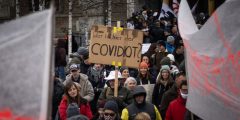Superimmunity
February 11, 2022
From the start of the pandemic in the distant spring of 2020 linguists and communication researchers have kept an eye on language. They observed the emergence of new words, such as ‘covid’ and ‘covidiots’ and the increase in use and understanding of older or jargon words, such as pandemic, coronavirus, lockdown, social distancing, bubbles, and …
Covid, cowering and cowardice
July 25, 2021
We all remember Boris Johnson saying in March 2020 that we should take covid on the chin, followed by him saying in April that year that Covid was an invisible mugger that one should wrestle to the floor. This metaphorical framing of the virus as a physical assailant and of those having to deal with …
Coronavirus and mental health: Risks, protective factors and care
July 2, 2021
This is a guest post by Dr Rusi Jaspal who is Professor of Psychology at Nottingham Trent University in the UK. E-mail: rusi.jaspal@ntu.ac.uk Twitter: @ProfRJaspal *** For several years, my colleagues and I have studied the effects of major social change on people’s sense of identity and psychological wellbeing. We have done so primarily through …
Covid, consensus and conspiracy: Mapping a change in narrative
June 25, 2021
I have written about the concept of consensus before, in the context of climate change. Now it’s time to write a few words on how consensus is used as a concept in the context of covid, or more precisely, in the debate about the origins of the coronavirus. The emerging literature surrounding this origin story …










